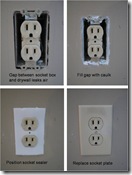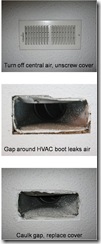The heating and conditioning of the air in your home generally accounts for 50% of annual energy consumption; thus, improvements targeting this component yield the greatest returns with the shortest pay-back times. Generally, the low-tech solutions discussed below should be expected to reduce HVAC energy usage by at least 1/3, which translates into about a 17% reduction in annual energy usage.
 The two easiest ways to improve the performance of HVAC systems are to (1) ensure that air filters are changed and debris is removed from air intake covers regularly and (2) adjust your thermostat levels to reflect recommended efficiency settings of 68°F in the winter and 78°F in the summer. Deviation from recommended settings results in reduced efficiency of 8-10% for every 1°F departure from the recommended setting.
The two easiest ways to improve the performance of HVAC systems are to (1) ensure that air filters are changed and debris is removed from air intake covers regularly and (2) adjust your thermostat levels to reflect recommended efficiency settings of 68°F in the winter and 78°F in the summer. Deviation from recommended settings results in reduced efficiency of 8-10% for every 1°F departure from the recommended setting.
Loss of conditioned air from and/or the introduction of unconditioned air into living spaces occurs in the floors, walls and ceilings.
 Floor loss may occur under door sills as well as around the entire base of the wall in which the door is located. Door sill losses are easily mitigated with door sweeps either under or on the outside of the door.
Floor loss may occur under door sills as well as around the entire base of the wall in which the door is located. Door sill losses are easily mitigated with door sweeps either under or on the outside of the door.
 Floor loss may also occur as a result of the creation of thermal pockets as a result of poor insulation below the sub-flooring. With regards to sub-flooring, holes where pipes and wires have been run should be sealed with spray-foam; however, occasionally larger holes (1) exist which must first be reduced in size using insulation board (2) before applying spray foam (3) and covering the opening with the proper insulation (R-19 in crawl spaces, R-30 in attics).
Floor loss may also occur as a result of the creation of thermal pockets as a result of poor insulation below the sub-flooring. With regards to sub-flooring, holes where pipes and wires have been run should be sealed with spray-foam; however, occasionally larger holes (1) exist which must first be reduced in size using insulation board (2) before applying spray foam (3) and covering the opening with the proper insulation (R-19 in crawl spaces, R-30 in attics).
 Wall loss is associated with poor seals around door jambs, windows and wall sockets. Reducing airflow for these types of situations generally only requires caulk. Inadequate sealing between the door and the doorframe generally requires weather stripping. Occasionally it is necessary to adjust the position of the lock striker plate to ensure that a good seal/contact remains between the door and the weather stripping when the door is locked. In addition to caulking around wall socket boxes, insulating wall socket covers further dampen airflow through electrical outlets.
Wall loss is associated with poor seals around door jambs, windows and wall sockets. Reducing airflow for these types of situations generally only requires caulk. Inadequate sealing between the door and the doorframe generally requires weather stripping. Occasionally it is necessary to adjust the position of the lock striker plate to ensure that a good seal/contact remains between the door and the weather stripping when the door is locked. In addition to caulking around wall socket boxes, insulating wall socket covers further dampen airflow through electrical outlets.
 Ceiling loss results from poor seals around attic access points, FROG storage closet access points, HVAC vent returns and recessed lighting, and from thermal pockets created by inadequate attic insulation. Because heat rises, ceiling loss is especially important to correct during cold, winter months. Sealing up ceiling vent air return lines (as shown on the right) generally only requires caulking between the fitting frame and the ceiling material.
Ceiling loss results from poor seals around attic access points, FROG storage closet access points, HVAC vent returns and recessed lighting, and from thermal pockets created by inadequate attic insulation. Because heat rises, ceiling loss is especially important to correct during cold, winter months. Sealing up ceiling vent air return lines (as shown on the right) generally only requires caulking between the fitting frame and the ceiling material.
If accessible from the attic, spray foam can be applied to the ‘back’ of recessed light fixtures and exhaust fans; however, if not accessible, duct tape can be used to seal up ‘internal’ holes in these devices that permit air flow between the fixture and the attic. Note: recessed lighting requires these holes for heat transfer to prevent overheating, so in addition to sealing up the holes the light bulbs in these fixtures should be also be replaced with lower wattage, preferably compact fluorescent bulbs that do not generate as much heat.
Fixing seals on attic access openings is more complex than ceiling fixtures due to the larger space involved and mobile nature of the attic access door. Airflow through attic access points generally stems from inadequate contact between hatch covers and frames, a condition that is worsened when hatch covers become warped with time (1). Although poor contact may seem inconsequential from the outside, examination of the extent of airflow through these gaps from the perspective of the attic reveals that they are incredibly porous, as evidenced by the amount of ambient light that penetrates (2,3). Mitigation of air loss through attic access openings can be achieved by applying a foam-based weather stripping to the hatch frame so that the hatch seals shut (4). Replacement of hatch covers may also be necessary if they are warped. It is also advisable to attach insulation board to the back of the hatch cover (5) to increase the R-value of the actual cover as well as add additional weight to help the hatch cover stay sealed and reduce future warping. As shown in the final image (6), which I certify is an actual photograph from the same perspective as image #2, these simple improvements really work!
After implementing these standard mitigation techniques, turn on exhaust fans in your home to create air flow that will identify additional drafty spaces that need attention. For more precise identification of thermal pockets and drafty spaces in your home you can also schedule a blower door test and thermal scan. The Home Energy Group performed these tests in my own home which exposed some problem areas not discussed above, but also required me to spend $325; thus, it is best to eliminate the universal problems first to isolate the home-specific issues and get the most benefit from a blower door test and thermal scan later.
Click here for Water Heating mitigation


